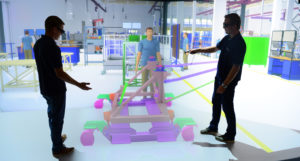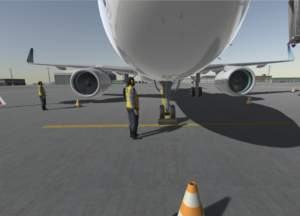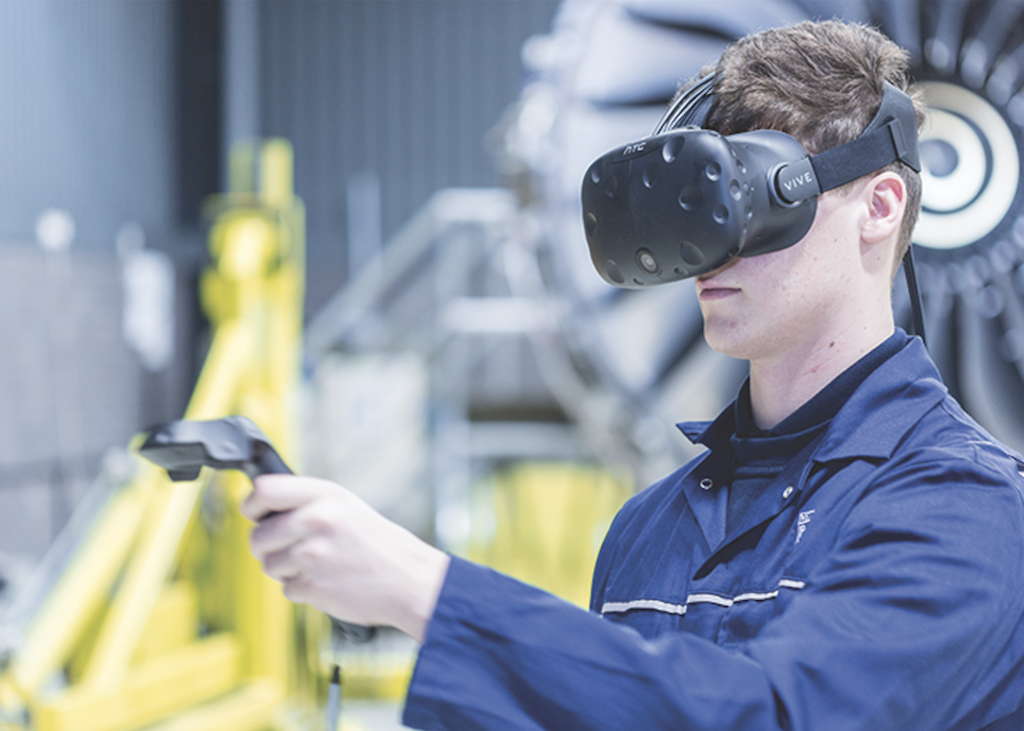Words by Steve Johnson
Virtual reality offers companies the opportunity to reduce the cost and increase the effectiveness of safety training for ground operations.
Virtual reality technologies appear to be on the way to becoming an aviation mainstream. Simulation is a well-established tool for pilot training. In recent years, ground handling and safety training programs are now beginning to take advantage of the digital world’s capabilities and flexibility.
Market researcher IDTechEx reported last month that by 2030 the augmented (AR), virtual (VR) and mixed reality (MR) optics and display market will total over US$28 billion. Pre-Covid-19, aviation’s use of these technologies was projected to grow from US$78 million in 2019 to US$1,372 million by 2025.
The Covid-19 pandemic could be a further catalyst for growth in the use of VR in aviation, out of necessity. The European Union Aviation Safety Agency (EASA) recently revised its guidance for virtual classroom instruction and distance learning, reflecting a major shift in the sector towards more use of online learning and virtual classroom instruction. In addition, early adopters of VR, AR and MR, otherwise known as immersive technologies, are realizing several benefits in terms of application and user value.
If VR is good enough for in-flight training, similar technology should be suitable for training in ground handling operations. Dr Benjamin Goodheart, founder and principal consultant of Magpie Human Safety Systems says, “Making a comparison of operating an aircraft in flight and ground handling isn’t exactly fair, but the same asset is being operated in a dynamic environment with complicated risks.
“That aviators rely on simulator training in the classroom, but ground handlers do not, highlights one of the enduring issues in aircraft operations.”
On-the-job training for ground operations staff is problematic. Ground handlers find it challenging to build training programs into what’s going on operationally. It is not easy to arrange for aircraft to be available for multiple training scenarios. Combined with the variation in ground handling vehicles and the requirement to practice in different light and weather conditions, the capability to recreate and control an immersive digital environment for training purposes begins to make sense. However, up until recently, the VR technology required has been prohibitively expensive.
From a technical viewpoint, Dr Charlotte Coles, IDTechEx’s technology analyst, confirms the suitability of VR for aviation. “The technology can play a role in filling the skills gap across many different areas, especially training in extreme or specific environments,” she says. “The immersive capability of VR has improved in terms of optical components and micro-displays. Gains in this area have allowed clients to create an immersive experience comparable to real life, allowing users to train and hone their skills in work environments.”
On the ramp

Trade association IATA began developing its RampVR training software in 2017 with three goals in mind: to enable the faster integration of new employees into live ramp operations, to improve knowledge retention and to create a better learning experience. RampVR is currently being used by Fraport at Frankfurt Airport, Germany, by Basel Euroairport in Switzerland and by Qatar Aviation’s ground handling organization. Dimitris Sanos, senior product manager of fuel and ground operations training at IATA says, “We make sure that the user experience, the transition from being in a room with a VR headset on, to being on the ramp and an aircraft has just arrived, happens in just a couple of minutes. If objects, the environment and conditions are not realistic then the user dismisses the solution and focuses on the differences between reality and VR.”
IATA expects that improvements to VR, such as fully wireless headsets that can cope with demanding graphics and higher resolutions, will aid its uptake in the future.
Content is king
Surrey, UK-based Diverse Interactive is a VR-software developer that works across several sectors, including aviation. Co-founder, Jake Kuliczkowski says, “We have experienced a sharp increase in enquiries from businesses interested in immersive technologies. As a result of Covid-19, there is an opportunity to build a stronger business case for VR now more than ever before.”
According to Diverse Interactive, most of aviation’s previous experiences of using VR has led to quality issues when real-world scenarios or environments have not been sufficiently representative. The result is reduced engagement in training, which has limited the return on investment (ROI). The VR content therefore needs to be high quality in terms of the production and the creative input from both the training and immersive technology providers.
Producing a business case for any new technology spend and ultimately a ROI is rarely straightforward and VR is no exception. Kuliczkowski says, “Working with a provider that understands the learning objectives, user experience and suitability of the technology is absolutely key to ensuring the ROI and desired outcomes. If applied correctly, the use of VR and AR in a training environment can transform learning.”
But there are reservations about the extent to which the market is ready to use VR for training. Goodheart says, “Conceptually, our sense is that ground operators are all for it. But taking the leap from thinking it is a good idea to funding the development of a system with enough fidelity to be useful is something the market has shied away from in our experience.
“The cost can’t be supported at a single location, because no ground handler has enough need, and most aren’t inclined to send employees off-site for training. One solution would be a trailer-able device that can be driven to facilities on a rotating basis.”

There is a long way before the growth predicted by market research companies in immersive technologies is realized. However, the technology can successfully address a whole raft of training issues versus on-the-job and classroom methods. Savings can be made by not having to tie up expensive winged and wheeled assets by using VR, but upfront development costs have to be funded before the returns can be achieved.
Addressing the way forward, Kuliczkowski says, “We need to start seeing mass consumer adoption of VR to make platforms and hardware more accessible to business. It’s happening, but a little slower than experts predict. The use of artificial intelligence and machine learning are going to further unlock opportunities. Algorithms will detect trends and indicators in learner behavior against live data, giving a level of insight that has never been possible before.”
The pandemic may in time prove to be an important catalyst, but IATA believes that demand for training and VR solutions is directly linked to the total number of employees who need training and refresher training. Aviation’s recovery from Covid-19 is expected to be a slow process. In some quarters training requirements could be postponed for months if not years. On the other hand, it is clear that there is energy and enthusiasm for immersive technologies.
The final and perhaps most challenging barrier towards adoption is that the power of VR, AR and MR for ground operations training is yet to be fully understood by the sector. Sanos says that when presenting RampVR, some senior managers had to be persuaded that it was not a video game. It may take until immersive technologies become mainstream for the usefulness of it in ground handling training to be fully realized. There’s nothing virtual about an unstoppable force for doing things better and delivering higher safety standards.





